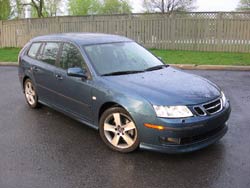 2006 Saab 9-3 Aero SportCombi. Click image to enlarge |
Review and photos by Chris Chase
Discuss this story in the forum at CarTalkCanada
Find this vehicle in Autos’s Classified Ads
Station wagons used to be a common sight in the suburbs. There was a time when mom and dad would load the family into the old Country Squire and head for the cottage. These days, minivans and SUVs hold rank as family haulers of choice for suburbanite families, but there seems to be a shift happening, one that’s bringing the station wagon back into vogue.
Well, what used to be called a station wagon is coming back, anyways. You won’t see that term much anymore, with only a few manufacturers – generally the ones like Subaru, Volkswagen, and Volvo who never stopped making them in the first place – sticking with the tried and true name for this “two-box” design.
Saab is one of the latest defectors to the “un-wagon” camp with the new-for-2006 9-3 SportCombi. Saab is perhaps better known for its hatchbacks, having built five-door slant-back versions of the previous-generation 9-3 and its 900 predecessor, as well as the 9000, which became the 9-5 in a 1998 redesign (despite the 9-3 SportCombi’s distinct station wagon shape, Saab calls it a hatchback, too). Speaking of the 9-5, a wagon version of that car has been around since 1999. Saab’s tradition of five-door cars could probably even be traced back to the so-ugly-it’s-cute Saab 95 of the 1960s. But we digress.
There’s a trend towards the “sexing-up” of newer wagons, and the 9-3 SportCombi fits the bill perfectly. Granted, the company chose a good starting point: the 9-3 sedan, introduced in its current form in 2003, is hardly homely. But it’s easy enough for things to go horribly wrong during the metamorphosis from sedan to wagon; the 1992-1996 Toyota Camry is a textbook example. In our opinion, this Saab is a terrific example of a practical wagon done right, with great looks to go along with the extra cargo space.
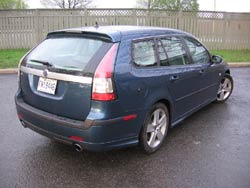 2006 Saab 9-3 Aero SportCombi. Click image to enlarge |
In place of the 9-3 sedan’s trunk, the SportCombi gets an angular rump with wedge-shaped taillights that stretch toward the roofline and give the car the appearance of being taller than its 1,443 mm reach for the sky would suggest. What’s not an illusion is the spacious cargo hold accessed through the large, square hatch opening. With the rear seats in place, Saab says the SportCombi will swallow 841 litres of cargo, compared to 425 litres for the sedan. With the rear seats folded, capacity increases to 2,047 litres. That’s a touch more than the Volvo V70’s maximum cargo capacity of 2,022 litres and far more than either of BMW’s wagons – the Touring versions of its 3- and 5-series – and Audi’s A4 and A6 Avant models. Other wagons can boast more cargo space with the seats in place, but by the numbers alone, only Saab’s own 9-5 SportCombi can carry more cargo than the 9-3: 2,067 litres of space with the rear seats folded.
Our tester was the uplevel Aero model, powered by a turbocharged version of General Motors’ new “high feature” 2.8-litre V6 and six-speed automatic transmission. Its 250 horsepower and 258 lb.-ft. of torque don’t sound like extraordinary power levels, but in action, this motor and smooth-shifting transmission pull the SportCombi around smartly, with the engine making very pleasant sounds when pressed. Saab’s long experience with turbocharged engines shines here, as this new motor makes none of the whistling and whooshing noises some turbine-fed engines produce.
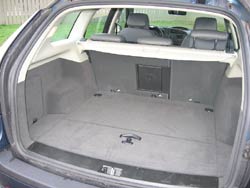  2006 Saab 9-3 Aero SportCombi. Click image to enlarge |
The only negative side effect of all that power is the torque steer that’s the result of it being routed through the front wheels. Audi, BMW and Volvo all offer their wagons with all-wheel-drive, while Saab does not. Our other complaint with the drivetrain was that the transmission seemed reluctant to downshift, something easily remedied by using the Sentronic manual-shift feature, which included nifty but mostly-pointless steering-wheel-mounted shift buttons.
To go along with the turbo six’s extra power, the 9-3 Aero also gets what Saab calls a “sport chassis,” which we can only assume involves stiffer springs and shocks than those used on four-cylinder versions. Whatever the case, our tester cornered flatly, with sharp turn-in and great balance, thanks in large part to accurate steering that transmitted just enough road surface feedback to the driver’s hands. As well, Saab’s “Re-Axs” rear suspension allows some passive rear-wheel-steering to help reduce understeer in hard cornering.
 2006 Saab 9-3 Aero SportCombi. Click image to enlarge |
We found the brakes could be a little grabby, but we had no issues with the stopping power available. The 17-inch alloy wheels and body add-ons (front lip spoiler, side skirts, rear skirt and spoiler) – all standard on Aero models – looked great, even if the big wheels and low profile tires tend to transmit a fair bit of impact harshness into the cabin.
Inside the car, the driver gets a nicely laid-out instrument panel, including a large central speedometer flanked by a tachometer and fuel, temperature and turbo boost gauges. Standard on all 9-3s is Saab’s useful “Black Panel” feature, which allows the driver to extinguish all dashboard illumination except for the speedometer, to eliminate distractions during night driving.
Unfortunately, the rest of the dashboard misses the ergonomic boat, festooned with a glut of buttons that are hardly intuitive. The radio proved particularly frustrating: display information is split between two screens, a small one in the centre stack and another atop the dash, and trying to figure out what info is where gets annoying fast. Also, the CD changer slot is positioned way low on the centre stack, below the climate controls and nowhere near the rest of the radio controls. Our other ergonomic nitpick is Saab’s console mounted ignition switch. Yes, it’s part of Saab’s heritage and sure it’s novel, but to us, ignition switches belong on the dashboard.
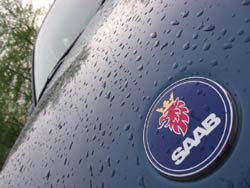 2006 Saab 9-3 Aero SportCombi. Click image to enlarge |
Also, our 9-3’s power mirrors refused to stay put, forcing us to adjust them almost every time we got into the car. While we believe this was related to memory settings accessed through a central computer system almost as unnecessarily complex as BMW’s iDrive, we simply couldn’t figure out how to get the mirrors to stay where we wanted them. There were also a couple of interior trim pieces that felt flimsy and cheap.
The 9-3’s interior is redeemed, however, by terrific seats. Aero models get nicely bolstered front chairs finished in an attractive two-tone leather scheme. Though not quite as supportive as the optional sport seats offered in BMW’s 3-series, these came close. While the 9-3 is no limousine, it feels roomier than the 3-series, but less so than the V70.
The 9-3 Aero SportCombi starts at $43,400; our tester’s optional six-speed automatic transmission (a six-speed manual is standard), touring package (which includes an auto-dimming rear-view mirror, three-position memory driver’s seat, rear parking assist, power windows, sunroof that can be opened remotely, and rain sensing windshield wipers) and Fusion Blue Metallic paint drove the base price up to $47,300, plus a $1,180 destination charge.
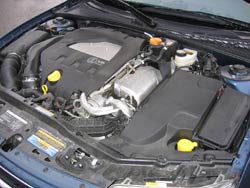 2006 Saab 9-3 Aero SportCombi. Click image to enlarge |
BMW’s 3-series Touring starts at $43,400 and is available with just one engine – a 215-horsepower inline six – and only with all-wheel-drive. The Audi A4 Avant comes with a base price of $42,200 and includes – again – all-wheel-drive and a 200-horsepower turbocharged inline four-cylinder. Opt for the 255-horsepower, 3.2-litre V6 and the base price increases to $49,335. The other high-end Scandinavian choice, the Volvo V70, starts at $39,120 with a 168-horsepower 2.4-litre five-cylinder engine. Move up to the 208-horsepower, 2.5-litre engine and the price moves up too, to $42,120. At the other end of the luxury wagon price spectrum is the all-wheel-drive Jaguar X-Type Sportwagon, which starts at a difficult-to-swallow $53,235.
The new 200-hp 2007 VW Passat Wagon 2.0T starts at $31,425 while the 280-hp V6 Passat Wagon starts at $44,115. The lone Japanese entries in the class are the Subaru Legacy and Mazda6 wagon. The Legacy wagon starts at a competitive $29,495, but with a 175-horsepower engine. To get the more potent 250-horsepower turbocharged engine, you have no choice but to go for the 2.5 GT LTD wagon, with a price of $41,795 – more fitting for the class, but on the high side for a company with the Justy, Chaser and Loyale in its family tree. Move to Mazda and the Mazda6 GS-V6 wagon starts at $26,995.
 2006 Saab 9-3 Aero SportCombi. Click image to enlarge |
All of this paints the 9-3 SportCombi as a pretty good deal on paper, as long as you can do without all-wheel-drive, a feature offered by all of its competitors. The 9-3 also loses out in terms of ergonomics, which are excellent in the Volvo, and decent even in the BMW, where interior user-friendliness has generally gone out the window of late. This Saab can’t quite match the solid feel of the Volvo or the German models, either. For these reasons, given the competition it’s up against, we probably wouldn’t choose the Saab, but we wouldn’t discourage someone taken by its strong engine, great looks and spacious cargo hold – all valid reasons to park this attractive “un-wagon” in your driveway.
Pricing: 2006 Saab 9-3 Aero SportCombi
Specifications
Competitors
Crash test results
Manufacturer’s web site










